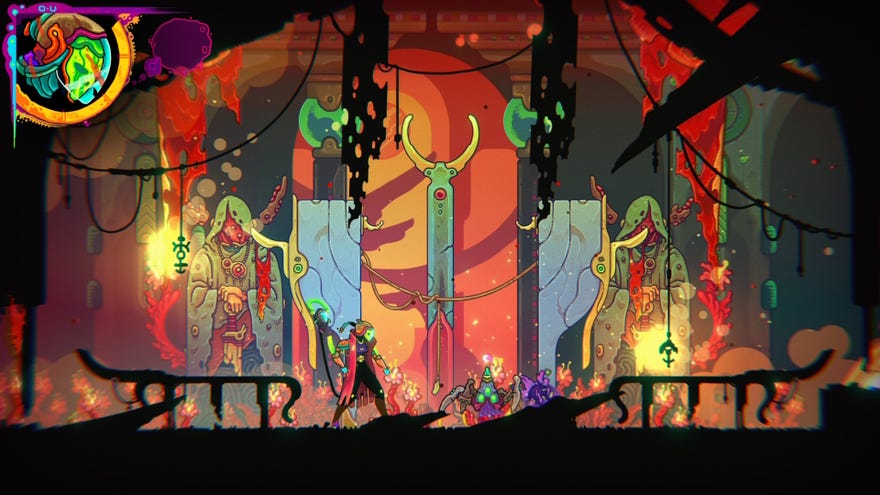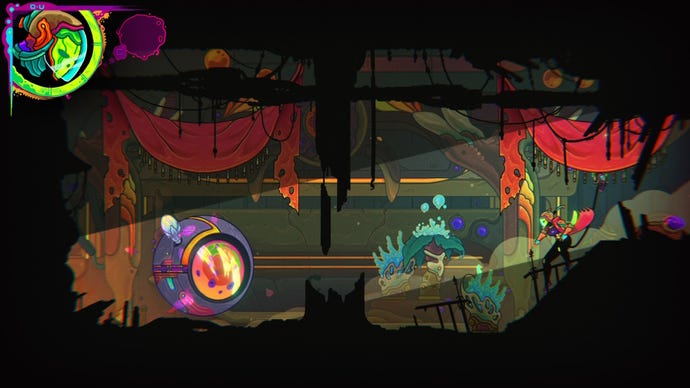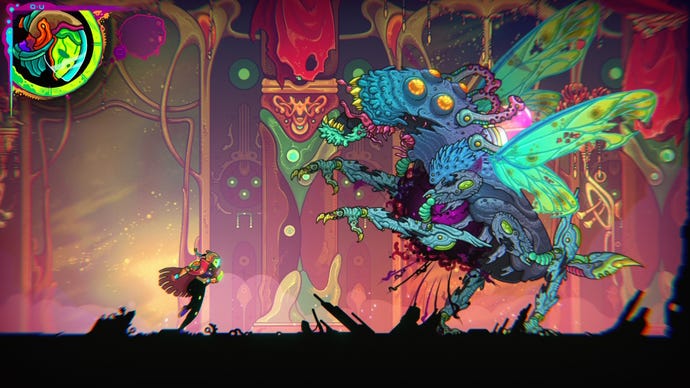HomeNewsUltros
How psychedelic gardenvania Ultros would have you “talk” to the aliensA quick chat with artist El Huervo about influences, from Cthulhu to Spielberg
A quick chat with artist El Huervo about influences, from Cthulhu to Spielberg
Image credit:Hadoque
Image credit:Hadoque

Ultros - First Look Gameplay Trailer | PS5 & PS4 GamesWatch on YouTube
Ultros - First Look Gameplay Trailer | PS5 & PS4 Games

In Ultros, you explore a huge, verdant, space-going Sarcophagus that exists to contain an ancient, demonic being, but is also a “cosmic uterus” for various other species (one of the developers became a father during its creation, and that experience is writ large in the premise). It’s a place of violence but also of nurturing, with players given the choice oftending the indigenous flora or hacking a path to their objectives.
The game’s environment art is the work of Niklas “El Huervo” Åkerblad, the Swedish artist and musician who devised the cover art forHotline Miamiand who also worked on Bestest Best adventureElse Heart.Break(). The Sarcophagus is probably his magnum opus, an enveloping greenhouse of stalks and fronds and fleshy mechanisms which, as it were, turns Åkerblad and Hadoque’s desire for a nicely joined-up gameworld into a question of anatomy.
Åkerblad looks for this kind of coherence in other gameworlds. “Sonic the Hedgehogspoke to me [as a kid] because I felt the world was more coherent and made more sense to me than Mario, for example,” he says. “Which was maybe more fun to play, but the Mario world was like an amalgam of very different ideas, that didn’t really feel coherent to me, until I read the comics.”
The Sarcophagus isn’t just cohesive - it’s saturated with the consciousness of its diabolical prisoner. Åkerblad draws a parallel with the work of Lovecraft. “The Cthulhu mythos - how that works is that Cthulhu is dreaming, but has such great psychic powers that, even if it’s almost dormant, it still invades people’s dreams, and sort of forms reality around it, without necessarily actively interacting with it,” he says. “And I feel Ultros is the same.”
Image credit:Hadoque


Åkerblad’s influences for the game include Miyazaki and Studio Ghibli - he cites eco-fable Nausicaä Of the Valley Of The Wind especially for its depiction of a “natural world” that is both wondrous and terrifying. But in regards to the act of communicating with nonhuman life, he also points to Western film-makers such as Spielberg.
“Close Encounters of the Third Kind, with the music and everything - I feel like, why don’t we get into that more?” he says. “I really like the way the aliens in that film communicate with us through music, because they can sort of better convey emotions that might resonate with us. And I think of the aliens in Arrival - like their language, and how language forms a culture, is very interesting. But I feel like it’s more like a visual thing, with the ‘coffee stain’ circles they’re doing. And the level of complexity in that language seems a bit [gratuitous] - to me it feels unnecessary to have such a complex writing language.”
Heptapod- Arrival 2016Watch on YouTube
Heptapod- Arrival 2016

It doesn’t sound like you’ll be penning letters to a demon in the game, though the world isn’t devoid of the written word - Hadoque fall back on descriptive text for elements like control inputs or dialogue with certain characters. Still, Ultros remains an enigma. “It’s like an entity that exists on different planes to us, and thus affects its environment subconsciously,” Åkerblad goes on. “Or not even like that. It’s more like how an artist does things - like, if you paint a painting, there is an intent, but it might land very differently with the viewer, if you understand what I’m saying. So Ultros influences its environment, but you might interpret it differently.”
It’s tempting to read this remark as an accidental spoiler. If Åkerblad himself turns out to be the demon at the centre of the Sarcophagus, a laJohn Romero and the Icon of Sin, you heard about it here first. Anyway, if you like the cut of all this, and I’m certainly keen to have a delve, there’s still time totry the demobefore next week’s launch - and Katharine’s full review.